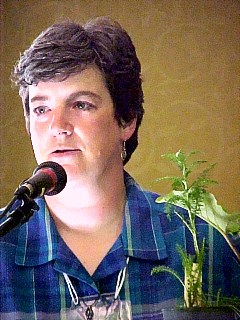Weeds, says Suzanne Hanna, can be a gardener's best friend.
That might sound odd coming from the president of the Sault Ste. Marie Horticultural Society, but Hanna insists that nature often has its own reasons for putting weeds where we wish they weren't.
"Not every weed is a bad weed," she said during a well-received presentation Saturday at the Ontario Horticultural Association's 96th Annual Convention, underway this weekend at the Sault's Best Western Inn.
Suzanne's potted dandelions
In fact, Hanna is so convinced of the usefulness of dandelions that she cultivates some of the things in pots and keeps them near her tomato plants.
Dandelions are dynamic acccumulators -- their tap roots absorb large amounts of iron, copper and other nutrients from the soil, she says.
They also attract bees that pollinate her tomatoes, and perhaps best of all, they exhale ethylene gas that makes tomatoes ripen faster and turn red.
Milkweed
If you thought milkweed is a noxious plant, think again.
Hanna buys milkweed plants at New North Greenhouses (you'll often find her putting in a shift behind the counter there) to attract butterflies to her garden.
Monarch caterpillars feed solely on milkweed, and the four plants she bought last year persuaded three monarchs to settle in her garden and build cocoons among her grape vines.
Indicator weeds
The presence of weeds (not just one, look for accumulations of plants) can indicate what's wrong with your garden or lawn, Hanna says.
For instance, a lot of chickweed suggests you have a lot of high-organic content at the surface, but little mineral content.
Quackgrass suggests wet anaerobic soil with high concentrations of aluminum.
Combinations of weeds can be especially accurate as indicators, Hanna believes.
For example, a lot of chickory and plantain in your lawn suggests compacted clay soil.
Hang on to a few plantain and thistles
It can nonetheless be a good idea to keep a few plaintain plants around your garden, says Hanna. Next time you're bitten by an insect, just crush the leaves and apply them to the bite for relief.
You might even want to leave a few thistles in the far corners of your property -- they'll attract black flies away from your picnic area.
Weed reduction
If you're still among those who view weeds as mortal enemies, Hanna offers the following suggestions for keeping them to a minimum:
- cover all bare soil with compost or other mulch - plant vegetables and flowers in patches - don't water your weeds - dig in your garden only when necessary - cultivate soil only at night. Fewer weed seeds will germinate.
Don't mention goutweed in her presence
Has Hanna ever met a weed she didn't love?
For sure, she tells SooToday.com. "I absolutely hate goutweed," she says, after recently digging up a root that went six feet deep.
Here, published with permission, are some of the recipes Hanna revealed during her talk:
Tansy Spray
Tansy repels flies and ants.
Mix one ounce of tansy with 1-1/4 cup (1:10) water. Process in blender and strain. Spray affected plants.
Liquid Weed Fertilizer
When we weed, we take out plants that have removed nutrients from the soil and stored them. Dandelions absorb three times the amount of iron from the soil than any other plant. It is a miser for copper and other soil nutrients.
To return this vitality to the earth, gather young weeds in early morning. Use one pound of weeds per three or four gallons and steep for two to three weeks. For a smaller batch, use one handful of weeds to one pint water and bring to a boil. Keep it covered as it cools
Strain and dilute with four parts water. Stir 10 minutes and then add one tsp. dish soap such as Ivory.
Use as soon as it is blended, as a foliar feed in a sprayer. One gallon of weed feed should treat 100 square feet of plants.
If using as a soil drench to feed roots, omit liquid soap from recipe.
Stinging nettle spray
Be sure to wear gloves. Stinging nettle spray can help plants resist infection from many fungal diseases. Use for botrytis rot and powdery mildew and for repelling aphids and thrips. It also provides a good dose of trace elements.
Gather 1 pound of fresh nettles. Crush leaves and put in burlap bag or old pillowcase. Submerge bag in bucket containing one gallon of unchlorinated water (rainwater). Cover bucket, place in warm area and let sit one week. Odour will be strong. Strain and store extra concentrate in glass jars, no longer than one month.
To use: dilute nettle concentrate by adding five parts unchlorinated water to one part concentrate. Spray plants every two to four weeks.
Bracken Spray
This is effective against black fly on broad beans and runner beans but not against cherry black fly.
Gather the bracken when brown and brittle dry. Pulp leaves and store in paper bags until needed. Using a jar, measure four fluid ounces of bracken and pour on 14 fluid ounces of hot water, stir and allow to soak for 24 hours, strain and then bottle in airtight jars and keep out of the reach of children.
To use: dilute one fluid ounce of concentrate and add one gallon rainwater and spray each day for three days.
Aphid nettle tea
In small bucket, cover a few handfuls of stinging nettles with water. Add one cup tomato leaves and one finely chopped small onion. Leave to steeo for three weeks.
To use: When ready, strain and dilute with five parts water.
Mullein Spray
This spray is effective for controlling whiteflies.
Steep one part mashed mullein leaves with five parts water and spray on affected plants.
Weeder's Digest
To receive free, real-time E-mail updates of SooToday.com's exclusive coverage of local news, just send an Email with "SUBSCRIBE" in the subject line to [email protected].
This free service is provided courtesy of the community-minded businesses whose advertisements appear on these pages.
